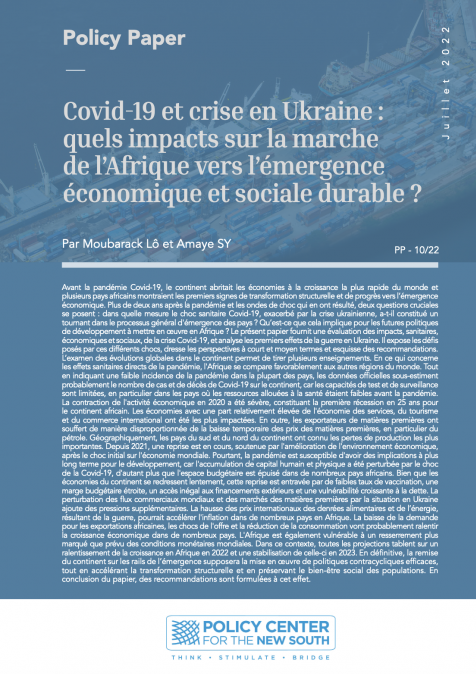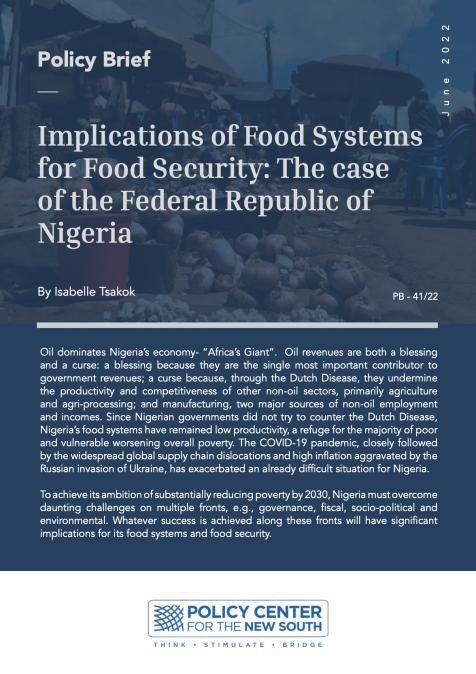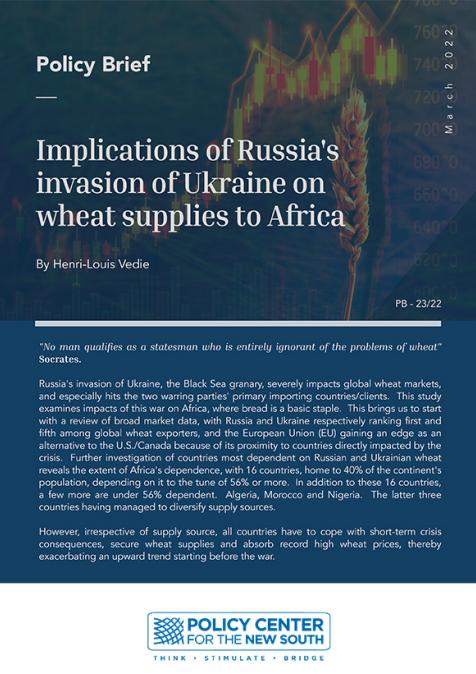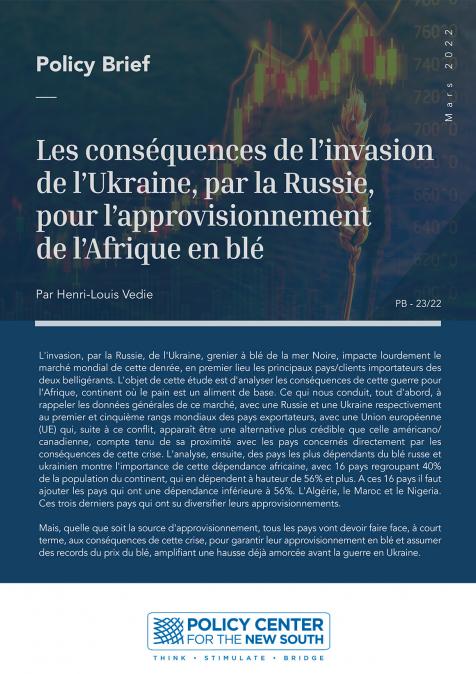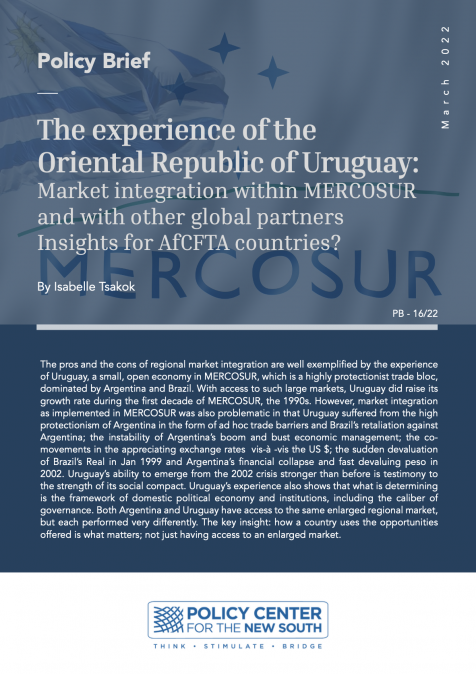Publications /
Opinion
Africa is endowed with an abundance of renewable (forestry, water, wind, solar) and non-renewable (extractives, oil, gas, minerals) natural resources. It is estimated that the continent accounts for about 7% of global oil reserves, 7% of natural gas, 20% of land area, 9% of renewable water resources and 17% of forests. The continent is also home to the largest or second largest world reserves of bauxite, cobalt, industrial diamonds, manganese, phosphate rock and platinum group metals, among other.
Such abundance of resources exposes the continent to several opportunities and challenges. In effect, if poorly managed, natural resources can lead to a curse and make countries vulnerable to the political and economic instability impacts of commodity price fluctuations, poor governance issues and negative social and environmental outcomes. However, if well managed and invested, wealth from natural resources could be a boon that boosts government fiscal revenues, accelerates Africa’s socio-economic transformation, and create jobs and opportunities for present and future generations.
Therefore, the real challenge for new commodity producing countries in Africa is to capitalize on the positive outcomes of extractive industries in a fashion that optimizes fiscal revenues, sustains the economic development, serves the best interest of local populations and favors direct and indirect local value retention and job creation.
In this context, policymakers have been searching for the best possible ways of utilizing natural resources and “local content policies” have taken a central stage in these studies/discussions. However, while there seems to be a growing interest among governments for such policies, several design and implementation issues restrain the ability to find workable and realistic options that align policy goals, general public welfare and business communities’ interests. Additionally, the complexity of these local content policies resides in the fact that they are country-specific, industry-specific and even project-specific. In other words, there is no magic panacea that could be generalized and successful experiences might not be fully duplicable.
This blog aims to explore some of the local content policy issues that new producing countries must take into account in their quest for optimal natural resources utilization. While it might not provide a one-size-fits-all framework, it attempts to highlight some of the key success factors and some of the most common errors based on the existing literature and some practical case studies.
Understanding, Defining and Visioning Local Content: The Starting Point
The first observation that strikes when studying some countries’ experience with local content is that many commodity producers do not have a clear notion, or an explicit statement, of what it is or the mechanisms through which it translates. This is extremely critical, because if you fail to define the concept, chances are that you will fail to design clear and realistic policies and have applicable/measurable objectives.
While local content is broad and changing in nature, as it is an ongoing and contextual process, it can generally be defined as a country’s effort to create value from extractive projects that goes beyond fiscal revenues by favoring linkages across the value chains in a way that benefits the local, national and regional economies.
The mechanisms of local content, the way it translates on the ground, vary from one country to another. However, the most common mechanisms observed are: local sourcing, small and medium enterprises integration in the extractives’ narrow or broad value chains, job creation, capacity and skill building and social initiatives (poverty reduction programs, health programs, among other). How each mechanism is defined, or which combination of mechanisms is adopted, is country/sector/project-specific and is dictated by various parameters that will be discussed later. For instance, some countries mention “national content” which supposes that inputs could be sourced from anywhere in the host country, while others focus on the importance of local sourcing from the resource rich regions specifically. Another example is that while some countries might define a local business based on the percentage of local ownership, other countries might define it based on country of registration. Understanding these specificities and making clear choices is important for successful policy design and implementation.
Once countries have an understanding of local content, its objectives and it mechanisms, they must have a legislative vision. Various experiences suggest that different alternatives exist in this regard. Some countries such as Ghana opt for a “Project” basis where individual contracts, such as the “Ghana-Tullow” agreement, clearly mention what is expected or required from an individual corporation that wish to operate in the country. Other countries, on the other hand, favor a broader universal approach to local content through national legislation. For instance, Nigeria via its “Nigerian Oil and Gas Content Development Act” of 2010 has provisions that emphasize and define local participation in all aspects of oil operations. A last set of countries choose not to legislate specifics of local content. They favor corporate-led/voluntary initiatives as a system to create local value. Determining which option is the most appropriate for a particular country is highly contextual and remains at the sole discretion of the policymakers of each particular commodity producing nation.
Policy Design: Exploring some of the Key Issues
The Global Environment and the Host Country’s Soundness and Level of Development
While designing policies, it is essential to have a full understanding and a fair assessment of the international and local environment. In fact, while local content mechanisms are decided at a country level, they must be coherent with the local and global realities in order to be applicable. A country must therefore have a fair evaluation of the international dynamics, the structure of the various value chains, the strength of the international actors of a sector, their inter-relations and the level of competition between them, the country’s own existing capacities, its macroeconomic soundness, the quality of its transport, energy, educative and social infrastructures, the strength of its ecosystems, the depth of its banking system and financial markets, the attractiveness of its business climate, the skills and cost of its labor, among other.
In other words, external and internal factors affect firms’ corporate strategies and determine to a great extent a country’s policy leeway and the possible mechanisms that it could put in place to optimally retain value from extractive projects. Indeed, a country that is, for instance, at very early stages of development with limited resources, limited infrastructures, weak ecosystems, unskilled labor and/or major macroeconomic unbalances cannot aspire to put restraining local content requirements for international actors that wish to operate in a certain sector. This would not make much sense from a business point of view, because such country does not have the necessary prerequisites or a sufficient competitive advantage or the unmatched incentives that grant it the needed bargaining power to negotiate with major corporations. Similarly, designing policies in a period of high commodity prices, abundant project-finance funds, dooming demand and flourishing private equity is naturally different from designing policies under adverse conditions.
National Growth Strategies vs. Sectorial Development Plans vs. Local Content Objectives
Assuming that a country has a thorough understanding of the internal and external environments, it is quintessential to harmonize the end goal of national strategies, sectorial plans and local content objectives when designing policies. In various cases, countries either do not have clear explicit national goals or fail to match them with coherent sectorial targets and local content requirements. Such situations create loopholes and contradictions and spread ambiguity among the various stakeholders in terms of their roles and obligations. It could also lead to conflicting policies, wasted resources, unmatched expectations, large discontents and conflicts of interests. Therefore, the coherence of a country’s ideological, economic, political and social orientations is at the essence of successful policy design and implementation. This coherence gives policymakers the needed sense of short, medium and long term objectives, capabilities, opportunities, challenges, needs, limitations and tradeoffs which undeniably inform and orient their policy choices. It also helps them identify the necessary measures or the corrective-actions that must be taken to mitigate risks, alleviate disjointedness and plan future imperatives.
The structure of the Sectors and the Projects’ Characteristics/Lifecycles
Another important pre-condition of a successful local content policy is having a deep understanding of the industries, their structures (both at a national and international level), their particularities and their requirements. This is very important because it enables policymakers to understand the dynamics, the strategies, the mindset and the motivations of various stakeholders and to put them in perspective with the country’s objectives and capacities (hence, whether the country offers investors all the prerequisites that would justify high local content requirements). Failure to have such comprehension could generate unbalanced policies and mechanisms that are in disconnect with global and local sectorial conjunctures and realities. This could in turn impede the existing or future operations by significantly reducing the profitability level to a point where projects become unattractive from a corporate standpoint. It could consequently deteriorate the business climate and reduce foreign investors’ wiliness to invest or expand their activity in a certain country.
If we take the extractives as an example, the sector has an exceptionally high capital-to-labor ratio. This means that companies in such sectors will most probably employ fewer employees (as a percentage of capital investment) than other companies operating in labor intensive sectors. Such realities must therefore be taken into consideration when setting local employment targets. Additionally, some key needs and services in the extractives are very singular and technical. In fact, the sector uses particular inputs and sophisticated technologies which can create difficulties to many countries that aim to create linkages with their domestic ecosystems. Certain core-technical jobs are also highly specialized and some host countries might not be able to supply sufficient and trained workforce. Setting overambitious local content targets under such circumstances can be counter-productive. It can create several gaps and bottlenecks in the chain that could lead to inefficiencies. It could also distort the various equilibriums.
Furthermore, the nature, size, risk, location and life-cycles of extractive projects is an important factor that must be taken into consideration by policymakers because it significantly orients the choices of appropriate local content mechanisms and targets. In this sense, it is important for governments to perform thorough analysis of extractive projects and their related transaction chains. This way, it is possible to identify supply-side (host-countries’ ecosystems and labor) and demand-side (International corporations/clusters) junction points and gaps (at various echelons and stages of extractive projects). That is very important if a host country wants to capitalize on the upsides and address the downsides with appropriately timed and quantified ex-ante and ex-post measures. The availability and free access to such intelligence/information (statistics, mappings, procedures, etc.) is also key for local companies to trust the fairness and clarity of the systems (procurement, service-providing, etc.). It could additionally foster good governance by enabling transparent/competitive biddings with clear pre-qualification thresholds and tender procedures. It could further encourage local SMEs to uplift their capacities to meet the sectors’ requirements (in terms of quality, volumes, pricing, etc.) to get their share of the business that extractive projects offer at various levels.
Local Content Paradigms and the Role of the Stakeholders
Assuming that a country has a clear vision and the necessary understanding of the different internal, external, endogenous, exogenous, short term and long term variables, it usually faces a delicate decision that will impact the entire local content policy design process: choosing a policy paradigm. In this regard, past experiences suggest that policy makers tend to favor/adopt “requirements”, “incentives” or “do-nothing” approaches.
The first approach consists of setting legally binding targets. Foreign companies under such configuration have the obligation to comply. The advantage of such approach is that it clarifies what is expected from the different stakeholders and leaves very little room to ambiguity or interpretation. However, adopting such strategy is not simple or clear-cut. Indeed, setting requirements implies that a government has sufficient qualified human capital, sound ecosystems and offers a unique environment that foreign companies can hardly find elsewhere (excellent infrastructure, a competitive fiscal regime, political stability, abundant proven reserves, etc.). Additionally, it implies that the host country has the necessary institutions and mechanisms to oversee the production and monitor foreign actors’ compliance with their legal obligations. It also supposes that the foreign investors have been consulted and are willing to fulfill their responsibilities, which in turn, is based on the assumption that policy makers have the necessary bargaining and enforcement power. In other words, several ifs condition the success of such “requirements” based “government-led” approach. Angola, Nigeria, Kenya and Ghana are example of countries that opted for this model.
The second approach is relatively more flexible and consists of using incentives as a way to encourage foreign companies to engage in local content initiatives. Under this configuration, governments offer companies that create local jobs, procure local inputs, empower local SMEs or contribute to knowledge and technological transfer through different type of incentives (mainly fiscal) to encourage them to sustain such actions. This approach is based on the assumption that a government is able to afford reduced fiscal revenues as a result of incentives. It also assumes that extractive companies are responsible, committed and capable of adopting self-regulation. In other words, it requires a high level of trust and dedication from the different stakeholders and a “collaborative” approach to local content (between policy makers, private actors and any other relevant stakeholder). Australia and Canada are example of countries that opted for such paradigm.
The last approach, is the most flexible of all. It favors a “voluntary” and “private sector-led” local content policy. Governments might choose to apply this paradigm because they are aware of their constraints (financial, institutional, legislative, geographic, or else) or simply because they choose to adopt a liberal approach to attract foreign investors and develop an industry that would be otherwise be hard to set up with the host country’s sole resources. Under this configuration, there are no formally stated local content provisions and the private actors are free to use the mechanisms that they deem sufficient and appropriate. The idea is that by operating in free and favorable business and investment climates, foreign investors have good reasons to expand their activities further and this will have natural spillover effects in the overall economy of the commodity producing country. However, there are trade-offs that must be taken into account by policymakers when choosing this paradigm. In fact, efficient, productive and free extractive sectors need socially responsible practices, rational judgments and an irreproachable sense of ethics amongst all actors (which is not necessarily the case). Therefore, the risk is that without minimal oversight, there is room for unscrupulous behaviors, overexploitation of resources, environmental damages or marginalization of local populations or minimal/asymmetric local value retention. Botswana is an example of a country that opt for such liberal policy in accordance with its overall open market economic ideology.
It is worth mentioning that there no best or worse paradigm. In other words, success or failure is not certain and what has worked in a certain environment under a certain set of conditions might not necessarily work elsewhere. Each country must customize its perspective, remain flexible to adjust when needed.
The Adequacy of the Existing Legal and Institutional Framework
Once policymakers decide the way they want to approach local content, they must tackle the legal and institutional aspects. Often unsuccessful countries tend to tackle the question from a narrow prism. They fail to strike the right balance that makes economic sense and offers favorable conditions for policy success. Neither excessive nor insufficient nor conflicting laws and institutions can do any good to serve that purpose. Though, as hard as legislating (in practice) is, some general fundamentals are still worth considering to avoid unnecessary disappointments.
First, regulation must be adapted to the local content paradigm. As such, liberal approach advocates shall opt for lighter regulation then countries that choose to set strict local content requirements. Similarly, we would expect quantitative targets’ regulation to be precise and concise as opposed to qualitative targets regulation which would be more generic.
Regulation must also grant everyone the same level of rights and obligations. It should not permit entry-barriers or unfair advantages to some actors at the expense of others. This is very important if a country wants to have an attractive business environment that brings a sufficient level of FDIs to develop extractives sectors over the long run.
Coherence is also key to a successful legislation. Conflicting laws could create confusion among stakeholders. It could also lead to disputes that damage the country’s reputation and put investors into a state of uncertainty.
Additionally, regulation must be crafted in a way that allows monitoring (of private sector’s compliance with the law), encourages good governance and promotes best practices. In fact, if actors feel that legal texts are clear and that their action is auditable they will be inclined to fulfill their obligations to avoid conflicts with policymakers.
Finally, local content regulation should converge with the country’s relevant bilateral and multilateral trade and investment treaties and agreements such as WTOs’ General Agreement on Tariffs and Trade (GATT), the Agreement on Trade-Related Investment Measures (TRIMs), the General Agreement on Trade in Services (GATS), the Agreement on Subsidies and Countervailing Measures (ASCM) or the Agreement on Government procurement (GPA), among other. Unfortunately, by looking at the number of state-business disputes that are brought to various settlement mechanisms, it appears that some countries regulate local content in contravention of their bilateral and multilateral obligations.
In terms of institutional framework, countries must have capable institutions that oversee the compliance of the stakeholders with the existing regulation and monitor the local content policy implementation. The framework’s design varies from one environment to another depending on the aforementioned elements. For instance, some countries have dedicated government bodies in charge of both legal enforcement and performance monitoring while others choose to have independent bodies acting as agents for the state and interfaces with investors.
Policy Implementation: Exploring some of the Key Imperatives
The Role of the Government and the Extractives’ Actors
While the right policy design and formulation lays the foundations of a value-creating local content policy, implementation tends to be the real test of the policy’s success. In fact, having the right paradigm and the right legal and institutional framework is essential, but getting each actor to acknowledge his role, fulfill his commitments and show an irreproachable sense of ethics, integrity and social responsibility is something that cannot be taken for granted.
To succeed, governments and private actors must establish a climate of trust and work closely on most issues and particularly those related to the implementation of the various local content mechanisms. This is of outmost importance because if one of the stakeholders fails his commitments, the whole process could be jeopardized. In that sense, it must be generally understood that there are certain things that governments must do, other that private actors must work on and a last set of issues for which they must join efforts.
Governments must first and foremost provide basic infrastructure (roads, electricity, health, etc.) to enable smooth operation in the extractives sector. they must also guarantee a minimum level of ease of doing business for international companies. Such actors must find the competitive and fair investment and trade climates that enable them to synchronize/align their local and international strategies. Governments should also perform a comprehensive mapping of local suppliers and provide sufficient public data that reflects the reality of local SMEs’ capacity and capability. This will enable a realistic use of the various local content mechanisms that takes into consideration local opportunities and constraints. Governments must also have a deep and objective analysis of the level of local labor’s skills and knowledge as well as a detailed plan to address any knowledge gaps with the right institutional and funding vehicles. This will help set reasonable employment targets (if relevant) and work on short, medium and long term initiatives to meet the sector’s specific employment needs. Governments should also resist the temptation of over-nationalizing the extractives activity in a damaging way that could encourage rent-seeking and promote an unfair elite capture of most of the benefits (via shell companies owned by bureaucrats or their relatives or corruption of officials to get unlawful favors, etc.). They must, instead, promote transparent tendering and mention explicitly how local content provisions (if any) are factored in the tender evaluation process.
Private actors, cornerstones of any local content policy, have also responsibilities that must be fulfilled to help successful implementation. First, they must clearly communicate to the host country their explicit pre-requisites for integration of local workforce and SMEs as well as the international standards that they are bound by. This will enable governments to design the appropriate policy framework and address specific and targeted issues. It will also enable local suppliers to work on improving their offer (in terms of prices, volume, quality, safety, delivery, etc.) to capture part of the potential extractives business opportunities. Whether by obligation, by incentives or by self-initiatives, international extractive companies must also contribute (financially, institutionally, or else) to the uplifting of local SMEs’ and workforce. They must see it as a medium and long term opportunity to reduce costs while maintaining the same quality of service. In other words, they should consider local content as a chance to federate local communities in order to avoid social tensions that could threaten the very existence of their activity. Hence, they must find a workable formula that meets local governments and communities’ expectations and converges with their business strategies. Private actors should also identify the areas where integration is possible and set up mechanisms that can facilitates local participation in some layers of the value chain. For instance, they can break procurement needs into smaller contracts that can be satisfied locally or negotiate specific contractual arrangements (advance purchase orders or forward purchase agreements) to help small companies unlock new funding options and overcome any financial constraints that might impede their ability to cope with the sector’s demands. Above all, private actors must show an irreproachable sense of ethics and a high level of social responsibility. This is particularly important in flexible environments, where governments give companies freedom of action while trusting their ability to self-regulate and to give back to local communities.
Finally, governments and private actors can join efforts to address some of these specific issues, particularly those related to tackling knowledge and capacity needs. In effect, following a collegial approach can bridge differences and lead to consensual conclusions that satisfy all stakeholders. It can also enable an optimization of the financial and institutional resources. It also encourages dialogue, transparency and clarity of purpose, which are key to successful local content policy implementation. Lastly, governments and private actors could also benefit from this collaborative approach by sharing their respective expertise. This will, in turn, help them develop a common mindset that is essential to pursue common objectives.
The Ongoing & Changing Nature of Local Content Policy Implementation
One of the main impediments of a successful local content policy is the tendency to address it as a static, timeless and once-and-for all exercise. This is major fallacy that distorts some policymakers’ capacity to understand the broad context and to make fair judgments during critical situations. In fact, external and international environments constantly change, countries evolve (economically, socially, demographically, etc.), sectors transform and extractive projects go through various phases (exploration, evaluation, discoveries, development, production or abandonment) that involve different levels of investment and risk. Therefore, any local content policy must take into consideration these parameters and leaves sufficient leeway for changes and adjustments. In other words, a policy must be flexible enough to allow a sequential implementation and a realistic timeframe to achieve various targets and domestic linkages. This way, the host country’s capacity and local content provisions can move concomitantly (i.e. as a country develops, as its human capital and ecosystems straighten, as the economic conditions improve and as more players are eager to enter the market, targets can become increasingly compulsory/quantitative/detailed).
However, flexibility must not be confused with unpredictability. Indeed, having adjustable policies is just as important as having an overall foreseeable strategic orientation that gives international corporations the necessary visibility and the sufficient level of security to operate. Yet, both are not mutually exclusive. For instance, a country can absolutely have a structured local content framework that is applicable to all companies but at the same time accommodate a set of specific and well-defined exceptions (i.e. lighter local content targets or additional incentives) to reward early entrants, for example, for the risk that they are willing to take when investing in an untapped sector at preliminary stages. In sum, implementation is an ongoing, trial-and-error and state-of-the-art exercise that requires critical analysis, negotiation, adaptation, sound judgment and permanent assessment of impacts.
Saving vs. Spending vs. Redistributing Fiscal Revenues
A critical aspect of local value-creation is the management of natural resources revenues. Several countries have shown vulnerability in this regard. Past experience shows that extraction activities do not necessary make a country better off. they might result, in some cases, in “Dutch Disease” situations that can develop into a broader resource curse that could have disastrous economic and social consequences.
In fact, natural resources revenues have special characteristics that differentiate them from other fiscal revenues. This makes their management particular and challenging. First, these revenues are enormous and this could leave room to possible wastes or embezzlements of funds. It could also encourage governments to neglect economic diversification or sectorial expansion given the budgetary comfort that they enjoy as a result of large fiscal inflows. Natural resources revenues are also unevenly distributed both in time (various stages of projects) and space (different regions might have distinct proven reserves and a varying level of production and revenues). This means that commodities’ extraction or the sale proceeds are irregular and volatile. Therefore, it is sometimes hard for policymakers to plan the inflows or budget the outflows or make long term investments/commitments with a sufficient level of visibility and confidence. Such revenues also come with strong expectations. Indeed, local populations in resource rich regions desire short-term tangible improvements of their everyday life which complicates the equation further.
The allocation of these natural funds is hence problematic and full of tradeoffs. The decision to invest, spend or save is far from simple and experience shows that different countries opt for different options. Some countries create sovereign wealth funds while others create dedicated government agencies to manage natural resources revenues. Some countries invest these funds locally while others buy foreign assets. Some governments centralize these funds while others redistribute a percentage to local authorities to support domestic initiatives. Some countries spend part of these funds in infrastructure while others prioritize education, skills building or SMEs development programs. No formula can predict which option works best. Yet, policymakers must carefully study context and the different options to evaluate their short, medium and long term impacts. They must also consult the various stakeholders to have an informed sense of priorities and reasonable estimates of the gaps at different levels within various time horizons. Setting up the right governance mechanisms and institutions is also quintessential to guarantee the sound use of natural resources funds. A regular assessment is also necessary to capitalize on successes, point out failures and take corrective actions. Finally, policy makers must take into consideration the impacts of each decision (invest, spend or save) in their monetary policy. Undeniably, abundance of natural resources funds has impacts on a country’s inflation, exchange rate or trade balance, among other. That is why central banks must use the appropriate monetary policy tools to counterbalance any possible harms that could result from large fiscal inflows.
Monitoring Implementation and Insuring Proper Governance
The success of any local content policy depends to a great extent on good governance. In fact, a successful policy must be well designed, feasible but also simple to administer. Administration requires an adequate institutional framework that federate the different stakeholders. It also requires simple and standard measurement and reporting systems that capture enough data to verify the compliance of private actors with their commitments while eliminating unnecessary burdens that could constrain or discourage international companies. Procedures in such governance framework must be simple, clear and substantive and information must be transparent, up to date and accessible. This will create a fair and competitive operational climate and establish a tradition of best practices in the extractives sector. It will also enable the parliament and the civil society to check the work of the formal bureaucracy. It will further enhance credibility of the system, which in turn, is important to reach the broader consensus that is needed for a policy’s success. The governance frameworks should be periodically reviewed in coordination with the relevant stakeholders (i.e. private actors, local SMEs, financial actors, consultants, industry federations, regional economic communities, international organizations). In that regard, it can be a good idea to have a dedicated agency to coordinate and lead the entire review process.
Last but not least, political will is a key success factor. Absence of democracy, weak executive and legislative powers or absence of independent oversight bodies can create the opacity that encourages corruption and elite capture of an industry. In fact, past local content failures illustrate that the political elite had in some countries personally benefited from the absence of governance by creating shell companies, encouraging selective/uncompetitive bidding and tendering procedures, or explicitly requesting bribes. On the other hand, countries that were able to successfully achieve in-country value creation have unconditionally benefited from the full support of their political leadership. Such support dissuades elite misconducts and facilitates the enforcement and oversight of local content policy objectives.
Conclusions/Takeaways
In the light of what has been said, Africa is a resource-rich continent that is increasingly looking for in-country value creation opportunities. Local content is attracting growing interest among new commodity producing countries as a plausible approach that could maximizes fiscal benefits while improving a country’s economic and social welfare. However, while setting up local content policies, several design and implementation issues must be taken into consideration. Indeed, new commodity producers can draw on other countries’ key success factors and learn from their most common mistakes.
First, policymakers must understand that local content policies are ongoing, contextual, country-specific, industry-specific and even project-specific. In other words, there is no universal framework that could be used across countries and other countries’ successful experiences can solely be regarded as a valuable source of insight and inspiration.
Second, local content must be defined and narrowed. This is extremely critical, because if you fail to define the concept, chances are that you will fail to design clear and realistic policies and have measurable targets.
While designing policies, it is also essential to fully understand and fairly assess the international and local environment. In fact, while policies are decided at a country level, they must be coherent with the local and global realities in order to be achievable. In other words, under adverse economic climate or at early stages of development, countries must consider light local content provisions to conduce foreign investments. They can start tightening as they develop or as the environment gets better.
Additionally, policymakers need to harmonize the end goal of national strategies, sectorial plans and local content policies. Countries that do not have clear explicit national goals or fail to match them with reasonable sectorial targets and local content requirements create loopholes or contradictions that spread ambiguity among the various stakeholders in terms of their roles and obligations.
Another important pre-condition of a successful local content policy is the thorough understanding of the sectors, their structures (both nationally and internationally), their specificities and their needs. This enables policymakers to understand the dynamics, the strategies, the mindset and the motivations of various stakeholders and to put them in perspective with the country’s objectives and capacities.
Having set a clear vision and acquired the necessary understanding of the different internal, external, endogenous, exogenous, short term and long term variables, countries must choose the appropriate policy paradigm. Policymakers tend to adopt “requirements”, “incentives” or “do-nothing” approaches. It is worth mentioning that there no best or worse paradigm. Each country must customize its model, remain flexible and periodically assess the results and fine-tune when needed.
Once policymakers decide the way they want to approach local content, they must tackle the legal and institutional aspects. Often unsuccessful countries tend to tackle the question from a narrow or ill-adapted prism. They fail to strike the right balance of laws that are neither excessive nor insufficient nor conflicting. While this exercise is difficult in practice, any regulation must at least be coherent, adapted to the chosen paradigm, egalitarian in terms of rights and obligations, enforceable and convergent with a country’s relevant bilateral and multilateral trade and investment treaties and agreements.
While the right policy design and formulation lays the foundations of a value-creating local content policy, implementation tends to be the real test of success. To achieve the aimed objectives, governments and private actors must establish a climate of trust and work closely on most issues. It must be clear, however, that there are certain issues that governments must tackle by themselves, other that private actors must work on and a last set of issues for which they must join efforts.
Successful policy implementation is also a matter of adaptability. A policy must flexible enough to enable a progressive implementation in a realistic time horizon. This way, the host country’s capacity and local content provisions can move in tandem.
Management of natural resources’ revenues is another key challenges of policy implementation. Past “Dutch Disease” situations and broader resource curses illustrate the disastrous economic and social consequences of mismanagement. No formula can predict which option works best. Yet, policymakers must study, in concertation with the various stakeholders, the context and the different options in order to evaluate short, medium and long term impacts and take informed decisions.
This brings the issue of governance. A policy must be well designed, feasible but above all simple to administer. Administration requires simple, clear and substantive procedures. It also requires clear measurement and reporting systems. The collected information must be comprehensive, up to date and available to all the stakeholders. Periodic reviews must be performed in coordination with the relevant actors to assess the level of success and point any failures.
Finally, the above guidelines can only be fruitful if they are backed by a strong political will. Indeed, no policy can succeed if the environment in which it is designed is opaque or inegalitarian. Hence, the political class and the decision-makers in new commodity producing countries should lead by example to foster the public’s trust in the overall system.




